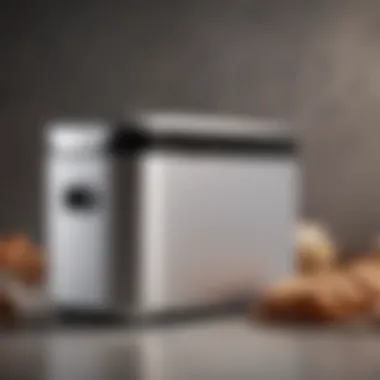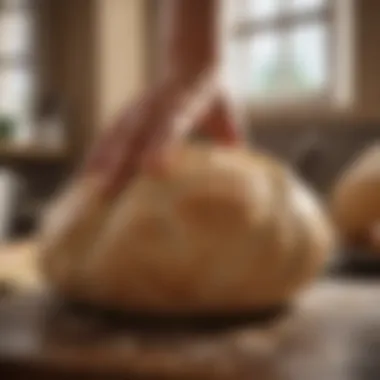The Ultimate Guide to Choosing a Bread Maker


Intro
In the world of home cooking, few tools can elevate your culinary experience like a bread and dough maker. Understanding the nuances of these machines can transform not only the quality of your baked goods but also the joy of creating them. This guide aims to delve into the essential components of selecting the best bread and dough maker for your kitchen. Key features, benefits of use, and maintenance practices will be discussed in detail.
Bread making is both an art and a science. For novice bakers, it can seem overwhelming, but with the correct machinery, it becomes much simpler and more enjoyable. The array of options in the market might appear daunting, yet this guide arms you with knowledge to navigate this landscape effectively. Whether you are a casual baker interested in experimenting with new recipes or a seasoned enthusiast seeking to refine your skills, choosing the right bread maker is crucial.
This guide will cover not only the technical specifications but also tips to sustain your equipment and preserve its longevity. Emphasis on informed decision-making is paramount, ensuring that your choice aligns with your culinary aspirations and home environment. Let's embark on this journey to enhance your baking experience.
Preamble to Bread and Dough Makers
Bread and dough makers have fundamentally changed how people approach baking. Their growing popularity reflects a desire for homemade goods without the intricacies that traditional baking demands. In this section, we will delve into what bread and dough makers are, their essential functions, and a brief overview of their evolution.
Definition and Purpose
A bread and dough maker is an appliance designed to simplify the bread-making process. These machines typically combine mixing, kneading, rising, and baking into one automated cycle. Users can measure and add ingredients, select the desired program, and allow the machine to do the rest. The primary purpose is to take the labor out of baking, making it accessible for those who may lack the time or skills for conventional bread-making.
Advantages include the ability to ensure consistency in texture and flavor, allowing users to experiment with different recipes with relative ease. Additionally, bread and dough makers also cater to specific dietary needs, such as gluten-free or low-carb options. This versatility makes them suitable for various cooking enthusiasts, from novices to more seasoned bakers.
Historical Context
The first home bread makers emerged in the late 20th century, particularly in the 1980s. Companies recognized the increasing interest in homemade food, prompted by a growing shift toward healthier eating and the artisanal food movement. Early models were basic in function, primarily focusing on bread creation.
Over time, technology and consumer demands led to enhancements in design and functionality. Modern bread makers now offer multiple settings for various types of bread and dough, as well as specialized programs for making pasta, jams, and more. This evolution highlights the device's role as a multifunctional kitchen tool rather than just a bread machine.
As the interest in baking continues to rise, bread and dough makers are more relevant than ever. They democratize the world of baking, allowing individuals with varying levels of cooking experience to create high-quality breads and doughs with convenience.
Benefits of Using a Bread Maker
Using a bread maker comes with various advantages that cater to the needs of both novice and experienced bakers. Understanding these benefits helps in appreciating the functionality and value a bread maker brings to your kitchen. It simplifies the bread-making process, making it more accessible and enjoyable for anyone who has an interest in baking. Here are some core benefits:
Time Efficiency
One of the significant advantages of a bread maker is time efficiency. Preparing bread manually can be time-consuming, involving multiple steps from mixing ingredients to kneading dough and finally baking. With a bread maker, much of that work is done for you. Simply add the ingredients to the pan, select the desired settings, and let the machine handle the process. Most modern bread makers can complete the entire cycle in a few hours, freeing up your time for other activities. This is particularly beneficial for busy homeowners who want freshly baked bread without spending too much time in the kitchen.
Customization of Ingredients
Customization of ingredients also stands out as a notable advantage. Bread makers allow users to adjust recipes according to personal preferences or dietary restrictions. Whether you have gluten intolerance or follow a specific diet, you can experiment with various flour types, including whole grain or gluten-free options. Apart from flour types, you can also control sugar content, choose healthy fats, and add seeds or nuts for texture. This level of customization leads to healthier options devoid of preservatives and artificial ingredients often found in store-bought bread.
"The ability to customize ingredients means you can enjoy your favorite bread while respecting dietary needs."
Consistent Results
Finally, consistent results make bread makers an excellent choice for anyone aiming for quality in their baking endeavors. Unlike manual methods, where human error can easily affect the outcome, bread makers maintain precise measurements, temperatures, and timings. This results in uniform texture and flavor every time you bake. Customers often report improved baking confidence thanks to the predictability provided by such machines. Even if you are not a seasoned baker, you can produce excellent results with minimal effort.
In summary, the benefits of using a bread maker revolve around time efficiency, ingredient customization, and consistency. These factors combine to create a favorable experience in bread baking, enhancing your culinary skills and overall kitchen enjoyment.
Key Features to Consider
When selecting a bread and dough maker, understanding its key features is crucial. This section dissects the most important elements that a consumer should evaluate. Each feature impacts the functionality and overall experience of using the machine. Those investing in such appliances must consider how each function aligns with their personal baking needs.
Size and Capacity
The size and capacity of a bread maker play a significant role in determining how well it fits your kitchen and baking habits. If you often bake for a large family or gatherings, choosing a model with a greater capacity is essential. Most bread makers have a standard loaf size, but it is wise to check the specifications carefully. A small machine may restrict the number of loaves baked at once, leading to increased time spent.
Another point to ponder is the available space in your kitchen. Some models have a compact design for easy storage, while others require more counter space. Measuring your available kitchen space can save frustration later.
Programmed Settings
Programmed settings enhance the versatility of bread makers. These settings allow users to choose from various baking options. For example, many bread makers include preset programs for different types of bread, such as whole grain or gluten-free variations. Programs make it easier to replicate specific recipes consistently.
In addition, some machines offer customizable settings. Home bakers can adjust variables like kneading time or baking duration to suit their preferences. For those keen on experimentation, unique programmed settings can offer more creative freedom.
Kneading and Baking Performance
The kneading and baking performance dictate the quality of the bread produced. A good machine typically features a strong motor to handle various dough types. Models that excel in kneading effectively mix ingredients and develop gluten, ensuring a better texture. The temperature control is also an important consideration. Even baking at the right temperature will contribute to a great crust and overall finished product. Users should look for machines with consistent performance to avoid disappointment.
Ease of Cleaning
Cleaning is often an overlooked aspect of kitchen appliances. A machine that is difficult to clean will discourage regular use. Features that aid in cleaning include a non-stick pan and removable parts. Most bread makers have pans that can be removed easily, making it simple to wash them. Additionally, some models are designed with fewer crevices where dough and crumbs can accumulate.
Users should think about the cleaning process when considering their options. A machine that saves time during cleanup can enhance the overall baking experience.
Price Range Analysis
Price is always a significant factor when purchasing kitchen appliances. Bread makers come in various price ranges, and each range typically correlates with features and quality. Higher-priced models may include advanced settings, better construction, and superior performance. On the other hand, budget-friendly options can still offer good value for casual bakers.


Before deciding, it's wise to set a budget and assess which features align with that financial plan. Investing in a quality bread maker can pay off in the long term. Buyers should keep an eye on reviews to gauge whether a machine is worth its price.
"Consider your needs carefully, as a well-suited bread maker can transform your baking endeavors."
Ultimately, carefully analyzing these features will ensure an informed decision. This assessment can significantly affect the experience and satisfaction level when using a bread maker.
Comparative Analysis of Popular Models
The comparative analysis of popular bread and dough maker models is essential in helping consumers make informed choices. Given the multitude of options available, understanding the distinctions between high-end choices, mid-range alternatives, and budget-friendly models can greatly influence the baking experience. Each category serves different needs and preferences, which can significantly affect user satisfaction and outcome. This analysis provides clarity and can simplify the decision-making process, ensuring that users find a device suited to their kitchen requirements.
High-End Options
High-end bread makers, such as the Panasonic SD-YD250, often feature advanced technology and superior craftsmanship. These machines provide multiple functions, allowing users not only to bake bread but also to prepare delicious jams and yogurt. The construction in these models typically involves high-quality materials, ensuring durability and longevity.
Key Characteristics:
- Versatility: Programs that manage various types of flour while automatically adjusting settings for different textures.
- Capacity: Larger loaf sizes and batch options tailored for families or gatherings.
- Smart Features: Integration with modern technologies, such as Bluetooth connectivity, enhancing user experience.
Investing in a high-end model can be beneficial for frequent bakers who value quality and functionality.
Mid-Range Alternatives
Mid-range alternatives provide a balance of functionality and price. Models like the Zojirushi BB-PDC20 are popular for those who seek reliability without breaking the bank. These machines typically include a variety of functionalities but might not feature the full range of high-end gadgets.
Considerations:
- Performance: Good kneading and baking performance, ensuring bread quality that meets expectations.
- User-Friendly: Intuitive interfaces that often make them easy to operate, even for beginners.
- Affordability: Prices generally range between high-end and budget models, making them accessible.
Consumers should find these models to be a smart investment that blends features responsive to daily baking needs.
Budget-Friendly Choices
Budget-friendly bread makers, like the Oster CKSTBRTW20, present straightforward solutions for occasional bakers or those new to the craft. While lacking some of the advanced features of their pricier counterparts, these devices meet basic requirements for making bread at home.
Key Aspects:
- Simplicity: Designed with fewer options, making them less complex and more approachable.
- Cost-Effective: Perfect for users with budget constraints or those unfamiliar with bread making.
- Size: Compact designs that fit easily in smaller kitchens without taking much counter space.
Choosing a budget model can be wise for those wanting to explore bread making without a significant investment.
The right decision on which bread maker to purchase involves balancing your baking frequency, available space, and budget constraints.
In summary, the comparative analysis of these popular models illuminates the diverse options available in the market. Understanding the features and capabilities of each model can empower consumers to select the one that meets their requirements more effectively.
Step-by-Step Guide to Using a Bread Maker
Using a bread maker can seem daunting for beginners, yet it offers a straightforward, simplified way to create fresh bread at home. This section provides essential steps that will help you to harness the full potential of your bread maker, transforming ingredients into delightful loaves with ease. The guidance is crafted with both novices and experienced bakers in mind, ensuring that anyone can replicate success consistently.
Preparing Ingredients
Ingredients play a critical role in the bread-making process. Accurate measurements can make the difference between a perfect loaf and a disappointing result. First, gather all necessary components before starting. This usually includes flour, water, yeast, sugar, salt, and any additional flavorings like herbs or nuts.
Pay close attention to the order of ingredients. Generally, liquids should be added first followed by dry ingredients. Yeast should be kept away from salt until mixing begins to ensure proper fermentation. Additionally, using high-quality ingredients can significantly enhance the taste and texture of your bread. Here is a brief guide for common ingredients:
- Flour: All-purpose is standard, but whole wheat or specialty flours can be used for unique results.
- Water: Ideal temperature ranges from 80°F to 100°F (27°C to 38°C).
- Yeast: Instant or active dry yeast must be fresh for the best results.
Choosing the Right Program
Bread makers typically come with a variety of pre-set programs designed for different types of bread and dough. Selecting the correct setting is crucial to achieving the desired result. For example, you might choose a whole wheat setting for denser bread or a quick bake option for faster production. Understand the particular settings your machine offers, as this affects kneading times, resting periods, and baking temperatures.
Aside from bread, many machines allow you to make dough for pizza or pastries. Take the time to explore these options, which can expand your culinary repertoire. Remember to familiarize yourself with your specific model's manual to utilize these functions fully.
Monitoring the Process
Although one of the conveniences of a bread maker is its ability to work independently, periodically monitoring the process is still beneficial. Initially, observe the mixing phase to ensure all ingredients are thoroughly combined. If necessary, use a spatula to push down any flour pockets or loose ingredients.
During the rising stages, the dough should double in size. Pay attention to the dough's texture; it should be smooth and elastic. If it looks overly sticky or dry, it may be necessary to adjust ingredients on subsequent attempts. Finally, towards the end of the baking process, an aroma of fresh bread will fill your kitchen, indicating that the loaf is nearing completion.
Storage and Serving Suggestions
Proper storage of freshly baked bread is essential to maintain its quality. After cooling, for short-term storage, wrap the bread in plastic or store it in a bread box to keep it soft. For longer-term options, consider slicing the loaf before freezing, allowing you to pull out only what you need. Always allow the bread to cool completely before wrapping to avoid condensation.
When it comes time to serve, slice the bread using a serrated knife for optimal results. Pair with butter, spreads, or use it in sandwiches to enjoy your homemade creation. Additionally, consider complements like jams, cheeses, or meats to enhance the sensory experience of your freshly baked bread.
"Baking bread is not merely an activity, it’s about creating the experience and memories attached to that journey."
By following these steps, you can effectively navigate the process of using a bread maker. Each stage, from preparation to serving, plays a vital role in crafting the perfect loaf.


Common Mistakes to Avoid
Mistakes in using a bread and dough maker can lead to unsatisfactory results. Knowing these common pitfalls is crucial for achieving optimal outcomes. Understanding what not to do helps bakers refine their skills and enhances their overall experience. Here are some key mistakes and solutions to avoid disappointment.
Incorrect Ingredient Measurements
Accurate ingredient measurements are fundamental in baking. Many people assume that a pinch here or there will not matter, but it can make a significant difference. Using too much flour can lead to dense bread, while too little can cause it to collapse. Likewise, the way ingredients are measured affects the final product's texture and taste.
To ensure success, use measuring cups and spoons specifically designed for dry and liquid ingredients. For dry ingredients, spoon them into the cup and level off with a straight edge. Liquid ingredients should be measured at eye level for accuracy.
Neglecting the Manual
Every bread maker comes with a manual that outlines its specific functions and settings. Many users overlook this resource and dive directly into baking without understanding the appliance. This can lead to improper settings, wasted ingredients, and failed attempts.
Taking the time to read the manual equips the user with knowledge about various programs, including gluten-free, whole wheat, or rapid bake settings. It also includes maintenance guidelines that prolong the lifespan of the device.
Improper Maintenance
Like any kitchen appliance, bread makers require proper maintenance to function optimally. Neglecting to clean the bread pan, kneading blade, and other components can lead to buildup, affecting performance and flavor of the bread.
This maintenance should not be complicated. After each use, wash parts with warm, soapy water. Avoid using harsh abrasives that can scratch surfaces. Periodically check the interior of the machine for crumbs and residue, as this could also impact future baking performance.
Regular maintenance helps ensure your bread maker delivers consistent results and has a longer lifespan.
By avoiding these common mistakes, users can enhance their bread-making endeavors.
Accuracy, awareness, and care will bridge the gap between mediocre and excellent bread.
Maintenance Tips for Longevity
Maintaining your bread and dough maker is crucial for enhancing its performance and extending its lifespan. Many users overlook this aspect, focusing solely on the immediate functionality and results. With proper care, these machines can continue to produce high-quality bread and dough for years. This section delves into key elements of maintenance that can truly make a difference in how well your machine serves you.
Cleaning Procedures
Keeping your bread maker clean is essential. Residual ingredients such as flour, sugar, and yeast can accumulate over time. This not only affects the taste of your baked goods but can also lead to malfunctioning units. Here are some steps to maintain cleanliness in your machine:
- Remove the Baking Pan: After each use, take out the baking pan and kneading blade. This makes it easier to clean the components thoroughly.
- Wash with Warm Soapy Water: Clean the baking pan and kneading blade with warm, soapy water. Avoid abrasive sponges that can scratch the non-stick surface.
- Wipe Down the Exterior: Use a damp cloth to clean the outer shell of the machine. Avoid submerging the entire unit in water.
- Dry Properly: Make sure all components are completely dry before reassembling the machine to prevent mold growth.
Tip: For stubborn residues, a mixture of baking soda and water can work wonders.
Storage Recommendations
Storing your bread and dough maker correctly is just as important as cleaning it. Proper storage minimizes wear and tear, preventing damage from dust and moisture. Here are some pointers:
- Store in a Dry Area: Place the unit in a dry, cool location, away from direct sunlight. Moisture can lead to internal damage.
- Keep Covered: Consider using a cover that fits your machine. This offers protection from dust and accidental spills.
- Avoid Stacking Heavy Items: Do not stack heavy kitchen items on top of the bread maker. This prevents unnecessary stress on the machine and maintains its integrity.
- Cord Management: Make sure the power cord is neatly coiled and not pinched or bent, which can lead to damage over time.
Ensuring that your bread maker is well-maintained is key to reaping long-term benefits and consistent performance.
Innovative Uses for Bread Makers
Bread makers are versatile appliances that extend beyond the simple creation of loaves. Their innovative uses can optimize your culinary adventures, making them invaluable for homeowners and cooking enthusiasts. Exploring these alternative capabilities allows you to fully utilize your bread maker, adding a range of flavors and textures to your meals that may otherwise require additional appliances.
Gluten-Free Options
Creating gluten-free bread at home can be challenging. However, many bread makers come equipped with specific settings that cater to gluten-free recipes. This allows those with dietary restrictions to enjoy fresh, homemade bread without the hassle of kneading dough manually. Utilizing specialized gluten-free settings often requires precise measurements and adjustments to common recipes, but the results can be quite rewarding.
When selecting recipes, focus on gluten-free flours like almond or rice flour. Incorporating ingredients such as xanthan gum or psyllium husk can enhance the texture. Many recipes also suggest mixing these flours to achieve a balanced result that mimics traditional bread.
Dough Preparation for Other Recipes
Beyond bread, bread makers are capable of preparing dough for a variety of culinary applications. This capability allows for the creation of pizza dough, pasta, and even pastries with little effort. The controlled kneading cycle ensures that dough reaches the correct consistency, which is crucial for the success of these dishes.
To make pizza dough, simply follow a standard dough recipe, adjusting the ingredients according to your desired thickness and flavor. The bread maker will handle the mixing and kneading process, saving time and effort. Likewise, making pasta dough can also be a two-step process: prepare in your bread maker and then roll out manually.
Making Jams and Compotes
Surprisingly, many bread makers can also double as fruit processors, turning fresh ingredients into delightful jams and compotes. This function is especially useful during harvest seasons when fruits are plentiful and can be utilized in various ways. Using a bread maker for this task adds innovation to standard preserves, allowing you to customize flavors without excessive manual labor.
To start making jams, select the jam setting if your machine includes one. Most recipes suggest combining fruit, sugar, and a little lemon juice. The machine will work through the process, stirring and cooking until the mixture thickens.
Uploading recipes to utilize your bread maker’s innovative functions significantly expands its role in the kitchen.
"The use of bread makers for diverse recipes not only showcases their functionality but also enhances meal preparation efficiency."
By embracing these innovative uses, a bread maker becomes an essential component of your kitchen arsenal, enriching your culinary repertoire and providing versatile options for various dietary needs and preferences.
Evaluating Your Needs and Choices


Choosing a bread and dough maker involves several considerations. Each feature of these machines can cater to specific needs. Understanding your preferences helps ensure that you select a device that matches your baking habits.
Assessing Your Baking Frequency
When thinking about a bread maker, consider how often you plan to use it. Are you a daily bread baker or someone who bakes occasionally? Regular users may value efficiency, durability, and a variety of baking options. Daily usage can justify investing in a higher-end model that provides advanced features and consistent performance. Conversely, occasional bakers might be satisfied with a simpler, budget-friendly model. This knowledge helps tailor your choice to fit a realistic usage scenario.
Space Considerations in Your Kitchen
The available space in your kitchen is crucial. Bread makers come in various sizes, and knowing your storage capabilities can influence your decision. Measure the area where you plan to store the machine to ensure it fits comfortably. A compact model might be suitable for smaller kitchens, while those with more counter space could opt for larger machines with additional functionalities. Having the machine easily accessible can encourage more frequent baking.
Budget Constraints
Budget is another significant factor. Determine how much you are willing to spend. Bread makers range from economical models to luxurious high-end options. If you are new to bread making, a mid-range product may suffice to start your journey. However, investing in a pricier model might be sensible if you prioritize features like multiple settings, high-quality kneading, or advanced technology. Always consider the long-term costs, including maintenance and accessories, to ensure the best value for your investment.
"Investing in a good bread maker not only enhances your baking experience but can also improve the quality of the bread you create at home."
In summary, assessing your baking habits, the available kitchen space, and your budget can assist in identifying the best bread maker for your home. Each element plays a vital role in narrowing down your choices, ultimately guiding you to the model that will fulfill your needs.
User Reviews and Experiences
Understanding user reviews and experiences is crucial when selecting a bread and dough maker. Feedback from actual users provides insights that formal specifications cannot convey. Such reviews highlight the practical aspects of a product, revealing how well it performs in real-world conditions. They offer a glimpse into the usability, satisfaction, and potential issues one might face during everyday operations.
User reviews can illuminate both positive and negative aspects of specific models. They often reflect personal experiences, which can vary widely due to different baking needs and preferences. As any baker knows, what works for one might not work for another, making it imperative to consider diverse opinions before making a purchase.
Positive Feedback
Many users appreciate the convenience that bread makers offer. The ability to pull freshly baked bread out of the machine with minimal effort garners substantial praise. For instance, some users frequently mention how easy it is to set up and operate the machines. The programmable settings simplify the baking process, allowing for effortless bread-making even for novice bakers.
Furthermore, users often highlight specific models' reliability and consistent results. Satisfied bakers frequently report that these machines produce high-quality loaves, which meet or even exceed their expectations in taste and texture. Additionally, customization options for ingredients enable bakers to create tailored bread that aligns with dietary preferences, which is a frequent point of positive feedback.
Common Complaints
On the flip side, users do express certain frustrations that are worth noting. One common complaint involves the size and capacity of various models. Some find that their chosen bread maker is too small for their household needs, leading to a sense of inconvenience. This sentiment often surfaces in reviews for both smaller, budget-friendly options and larger machines that may still fall short in capacity.
Another prevalent issue relates to the complexity of some features. While many appreciate advanced functionalities, some users struggle to navigate through multiple settings and presets. This can lead to dissatisfaction, especially for those who prefer straightforward operations. Moreover, the noise level during the kneading process can be bothersome, as reported by several users.
In summary, while user reviews provide valuable insights into the performance and usability of bread makers, they also highlight areas for improvement. Considering this feedback can play a pivotal role in making an informed decision. Evaluating both positive and negative experiences allows potential buyers to pinpoint models that best match their needs and expectations.
Future Trends in Bread Making Technology
The landscape of bread making technology is evolving rapidly. This evolution is pivotal for both home bakers and industries. Updated features and innovations provide a more efficient and effective baking experience. Understanding these trends enhances consumer knowledge and decision-making.
Smart Technology Integration
Smart technology has penetrated numerous household devices, including bread makers. The integration of smart technology allows users to control their machines from their smartphones. This means you can start baking remotely, receive notifications, and even adjust settings through an app. Features like programmable timers and recipe suggestions contribute to user convenience.
Benefits of smart technology in bread makers include:
- Remote Access: Initiate baking while you are not home.
- Customized Recipes: Receive tailored suggestions based on ingredients.
- Usage Tracking: Monitor the frequency and type of bread baked through an app interface.
As smart kitchens become ubiquitous, having a smart bread maker becomes increasingly essential. This technology also allows for updates and improvements via software, ensuring the device remains relevant.
Sustainable Practices in Manufacturing
Sustainability practices are becoming a priority in manufacturing across all sectors, including kitchen appliances. Consumers increasingly favor brands that adopt eco-friendly approaches. This shift results in bread makers that utilize less energy and use recyclable materials.
Some key sustainable practices in the manufacturing of bread makers are:
- Energy Efficiency: New designs focus on minimizing electricity use.
- Recyclable Materials: Manufacturers are using materials that can be recycled more effectively once the product's life span ends.
- Reduced Waste: Streamlining production processes to limit waste generation.
By supporting brands that prioritize sustainability, consumers contribute to a wider environmental impact. This trend reflects a growing awareness of ecological issues, making it a vital aspect to consider in future purchasing decisions.
Closure
In the realm of home baking, the decision to invest in a bread and dough maker can transform how one approaches the culinary craft. The conclusion of this guide serves as a pivotal segment, consolidating the crucial insights gathered throughout the article. A bread maker is not merely an appliance; it is a tool that can enhance a user's baking experience by simplifying processes and enabling creativity in the kitchen.
This discussion has highlighted several key elements surrounding the selection of a bread maker. Firstly, understanding the specific needs of the user is fundamental. Are you a casual baker or do you find yourself often experimenting with sourdough and artisan breads? Recognizing one's baking habits is essential for choosing an appropriate model.
Secondly, the benefits of utilizing a bread maker are manifold. From time efficiency to ingredient customization, these machines offer considerable advantages compared to traditional methods. This is particularly valuable for busy households where convenience does not have to come at the expense of quality.
Key Takeaways
- Assess Your Needs: Individuals should evaluate their baking frequency and the types of bread they wish to create. Understanding personal preferences can guide the selection of features necessary for satisfaction.
- Consider Functions: Different models offer various programmed settings. Knowing which settings will be most beneficial can aid in producing the desired bread type consistently.
- Reflect on Maintenance: Longevity of a bread maker hinges on proper care. Regular cleaning and mindful storage are vital components that protect the investment over time.
- Budget wisely: While there are high-end models with extensive capabilities, budget-friendly options also exist that can fulfill baking needs without overspending.
"An informed choice can significantly enhance your experience, allowing for greater exploration and enjoyment in baking."
Final Thoughts on Choosing the Best Model
Selecting the best model ultimately rests upon several individual factors. The landscape of bread and dough makers is diverse, each with unique features, performance capabilities, and price points. Homeowners should prioritize models that align closely with their specific requirements.
When contemplating a purchase, it is beneficial to engage in further research. Reading user reviews and understanding the experiences of other bakers can provide valuable context. Online platforms like Reddit and dedicated baking communities on Facebook offer insights that can guide decisions.
In closing, embarking on the journey of baking with a bread maker should invoke a sense of excitement rather than apprehension. With the right tool, every individual can discover the joy of creating delicious bread at home, enriching both their culinary skills and their kitchen experiences.







